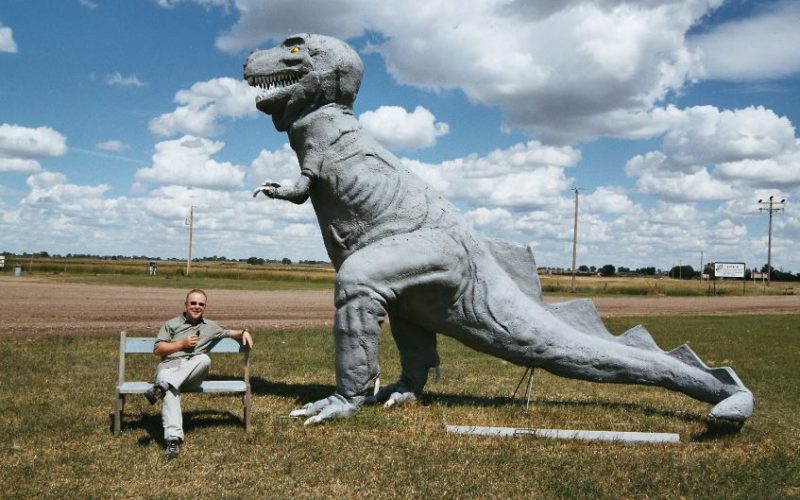On a mission to uncover the secrets of the Jurassic Mile
Dinosaurs Research impact and institutes Uncategorized 7th June 2019
A plot of land in the Badlands of Wyoming will soon be providing us with answers to both Earth’s past mysteries and – potentially – its future.
Beneath the surface of the ‘Jurassic Mile’ lies a treasure trove of fossil flora and fauna both big and small. Now, Professor Phil Manning and Dr Victoria Egerton from The University of Manchester are on a mission to unearth the site’s secrets. One thing’s for sure – it’s going to be roar-some.
Can you dig it?

The site is particularly special because it contains two major rock formations from the time of the dinosaurs – the Sundance Formation and the Morrison Formation. Sundance, which is made of shale, sandstone and limestone deposits on the bed of the prehistoric Sundance Sea, contains fossils of marine life like Ophthalmosaurus – a marine reptile. Meanwhile, the Morrison Formation was formed later and is rich with the fossilised skeletons of colossal creatures like Sauropods such as diplodocids and brachiosaurs, and Allosaurus – an older cousin of the Tyrannosaurus rex.
This particular dinosaur hunt is a truly interdisciplinary affair. Experts in palaeontology, botany, chemistry and geology will all be on-site to try and find out more about this land that time forgot.
By digging down through the layers of rock, the scientists will also dig down through the history of the Jurassic. In addition to fossilised bones, there are fossilised plants and ancient dinosaur tracks to investigate. The area is a veritable playground for scientists – a real ‘Jurassic’ park!
However, before any of this can begin, there’s a whole lot of digging to do. In a Tweet from the site, Dr Egerton revealed: “The pages of time are opening inch by inch, layer by layer. Soon we will be reading the story of some amazing dinosaurs.”
CSI Jurassic

In order to uncover the secrets of the site, both old school methods – a very big digger – and innovative technologies are being employed. In terms of the latter, the scientists plan to use The University of Manchester’s extensive range of imaging facilities to get a clearer look at what’s happening beneath the site’s surface.
Prof Manning notes: “It is splendid that such an important site has been discovered at just the right time, as the science of palaeontology is adapting existing and new imaging techniques to unpick the fossil remains of extinct life. The imaging work that we undertake at Manchester is already world-leading and this is a great opportunity to develop this research with other world-class institutions.”
Using this technology, the scientists hope to paint a more accurate picture of life during the age of the dinosaurs, such as what they looked like, how the creatures interacted with each other and what they ate.
During the Jurassic, colossal Sauropods roamed the land. These mighty beasts, which included Brachiosaurs, Diplodocus and Apatosaurus, could grow to reach lengths of more than 30m, and the largest are thought to have weighed as much as 120 metric tonnes. But what did they eat to grow to these humungous sizes?
It’s something of a mystery, as Dr Egerton explains: “During this period, there were no flowering plants. This site provides significant insight to what these giant animals ate and how they may have grown to be so large.”
Jurassic World

Prof Manning and Dr Egerton hope to not only answer questions from the past, but also to solve some of the problems the planet faces right now. The climate during the Jurassic period was subtropical and supported a lush green landscape. There were also no polar ice caps.
Understanding more about a climate that was warmer than experienced in most parts of the world today, and identifying how plant and animal life thrived in these conditions, could provide valuable information about the current climate crisis. Dinosaurs may yet save the day.
While that’s a long-term ambition, in the short term, some of the technology employed on the dig is already proving extremely valuable to 21st century science. The technology developed to scan and analyse these dinosaur graves forms the foundations of technology used to improve modern human brain scanning. In turn, this is helping to pave the way for improvements in the treatment of diseases like Alzheimer’s.
And, of course, the discoveries made by Manchester’s own Alan Grant and Ellie Sattler will inspire a whole new generation of dinosaur hunters. The University of Manchester is the academic lead on a project that includes the Children’s Museum of Indianapolis and the Natural History Museum, in addition to the Naturalis Biodiversity Centre in the Netherlands, as partners. It is hoped that at least two gigantic sauropod skeletons will be uncovered and added to the collection at the Children’s Museum of Indianapolis to inspire more young explorers.
With at least ten more summers of exploration at the site to go, we can’t wait to see what our scientists uncover. It’s going to be dino-mite.
Be sure to subscribe on our homepage to keep up to date with all the latest posts from The Hub.
Words – Hayley Cox
Images – The University of Manchester
DinosaursEarth and Environmental SciencesgeologyJurassic ParkpaleontologyPhil ManningresearchSEES




